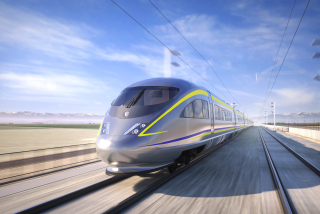Cost of Adding Rail Lines to Bay Bridge Put at $3 Billion
- Share via
SAN FRANCISCO — Adding rail lines to the San Francisco-Oakland Bay Bridge would boost the price of the current seismic retrofitting project by $3 billion, according to a new study.
Building rail lines would significantly increase the tab for the strengthening plan, which now has a price tag of $1.8 billion, the study reported. Officials called the added cost prohibitive.
“It’s absurd to think we could go about adding capacity to the Bay Bridge by spending another $3 billion,” said Contra Costa County Supervisor Mark DeSaulnier.
Supervisor Mary King said the analysis, which cost $325,000, was excessive and unnecessary.
“These studies are an absurd waste of money, satisfying a minority group [that] has obstructed the work on the bridge in any number of ways. Adding costs to an underfunded project is not feasible,” she said.
King has expressed frustration in the past with the slow-moving project, which has required the participation of several transportation authorities, as well as the Navy.
Meanwhile, seismic experts caution that the bridge should be retrofitted as soon as possible to prevent the kind of fatal damage caused by the 1989 Loma Prieta earthquake.
In that temblor, one end of a section of the upper deck collapsed onto the deck below, killing a motorist whose car fell into the gap. Dozens died in the rubble of a collapsed double-deck freeway approach to the bridge.
The analysis, commissioned by the Metropolitan Transportation Commission, was paid for by bridge tolls. Voters in Emeryville, Berkeley, Oakland and San Francisco overwhelmingly supported ballot measures calling for research into rail options in 1998.
Emeryville Vice Mayor Ken Bukowski, who pushed for the ballot measures, said the analysis essentially looked at the wrong rail options. He said voters were interested in cutting lanes to add rail lines, not building separate rail lines onto the structure.
“We never envisioned hanging rail off the side of the bridge and adding billions of dollars to the project,” Bukowski said. “We have always talked about using existing lanes. These studies are way out of line.”
He said he hoped something could be devised to simulate the Key System, an electric rail line that operated on the lower deck of the bridge from 1939 to 1958.
But it appears that the commission did indeed look at replacing lanes with rails, finding that adding a two-track line would cut vehicle lanes from five to two on the western span and from five to four on the eastern span.
The commission’s Steve Heminger said most transportation officials and politicians don’t want to cut vehicle lanes.
“We need to look at other options, such as running more express buses or increasing Bay Area Rapid Transit capacity, which can be done at a fraction of the cost,” he said.
More to Read
Sign up for Essential California
The most important California stories and recommendations in your inbox every morning.
You may occasionally receive promotional content from the Los Angeles Times.













